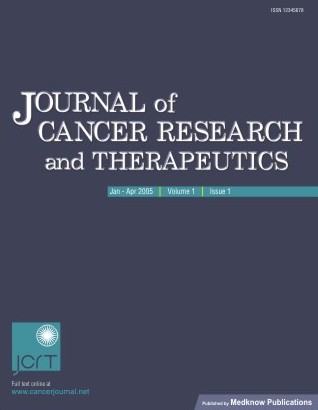
|
Journal of Cancer Research and Therapeutics
Medknow Publications on behalf of the Association of Radiation Oncologists of India (AROI)
ISSN: 0973-1482
EISSN: 0973-1482
Vol. 3, No. 1, 2007, pp. 8-11
|
 Bioline Code: cr07003
Bioline Code: cr07003
Full paper language: English
Document type: Research Article
Document available free of charge
|
|
|
Journal of Cancer Research and Therapeutics, Vol. 3, No. 1, 2007, pp. 8-11
| en |
Radiation dose to contra lateral breast during treatment of breast malignancy by radiotherapy
Chougule Arun
Abstract
Aims: External beam radiotherapy is being used regularly to treat the breast malignancy postoperatively. The contribution of collimator leakage and scatter radiation dose to contralateral breast is of concern because of high radio sensitivity of breast tissue for carcinogenesis. This becomes more important when the treated cancer breast patient is younger than 45 years and therefore the contralateral breast must be treated as organ at risk. Quantification of contralateral dose during primary breast irradiation is helpful to estimate the risk of radiation induced secondary breast malignancy.
Materials and Methods: In present study contralateral breast dose was measured in 30 cancer breast patients undergoing external beam therapy by Co-60 teletherapy machine. Postoperative radiotherapy was delivered by medial and lateral tangential fields on alternate days in addition to supraclavicle field daily with 200 cGy/F to a total dose of 5000 cGy in 25 fractions. CaSO4: Dy themoluminescence dosimeter discs were employed for these measurements. Three TLD discs were put on the surface of skin of contra lateral breast, one at the level of nipple and two at 3 cms away from nipple on both side along the midline for each field. At the end treatment of each filed, TLD discs were removed and measured for dose after 24h on Thelmador - 6000 TLD reader.
Results: The dose at the contra lateral breast nipple was to be 152.5 to 254.75 cGy for total primary breast dose of 5000 cGy in 25 equal fractions which amounted to 3.05-6.05% of total dose to diseased breast. Further it was observed that the maximum contribution of contralateral breast dose was due to medical tangential half blocked field.
Conclusion: CaSO4; Dy thermoluminescence dosimetry is quite easy, accurate and convenient method to measure the contra lateral breast dose.
Keywords
Breast malignancy, contralateral breast dose, secondary cancer, thermoluminescence
|
| |
© Copyright 2007 Journal of Cancer Research and Therapeutics.
Alternative site location: http://www.cancerjournal.net/
|
|
